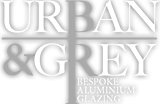Curtain wall systems can be custom-made and manufactured, although ‘off-the-shelf’ proprietary solutions can also be purchased. It’s possible to choose from both horizontal and vertical curtain walling which works well for both domestic and commercial projects.
Multiple glazing treatments are available for horizontal and vertical curtain walling; including transparent, translucent and opaque glass – or varying degrees thereof.
As curtain walls are non-structural, they can be made of lightweight material which greatly minimises overall construction costs. Generally, curtain walls are designed to be fitted within extruded aluminium members as its strength and stability meets all the necessary demands to support large glass areas to encourage abundant levels of natural light to entrance a property.
An increasingly popular method of glazing that’s equipped to enhance the living and working environments of residential and commercial properties, curtain walling is primarily used to create dramatic, attractive facades that allow maximum levels of natural daylight into small or large multi-storey buildings.
This solution is non-structural, which differs to many forms of traditional construction where all external walls are an integral aspect of a building’s primary structure.
Able to support their own weight
These bespoke glass living areas simply support their own weight and any loads imposed upon them, such as seismic or wind-related.
Did you know that curtain walling systems have been commonplace since the early 1930s? In fact, they first emerged on the scene as early as the 19th century with the advent of large glass panels.
Thermal breaks
In comparison with other building components, aluminium has a high heat transfer coefficient, which makes it a very good conductor of heat. However, this can translate into considerable heat loss through aluminium curtain wall mullions if there are no thermal breaks fitted to compensate.
Put simply, thermal breaks work as a barrier between exterior and interior metal and are often made of polyvinyl chloride (PVC).
The thermal breaks can greatly minimise the thermal conductivity of a curtain wall. Take our Swiss-engineered Supersun100 system for instance; which is designed to exceed guidelines on thermal efficiency for aluminium glazing with an extensively insulated cavity allowing us to deliver an uncompromised vision of light and spaciousness for our customers time and again.
State-of-the-art aesthetics
Our curtain walling includes a host of aesthetic benefits as well as industry-leading technical performance. Our toughened, laminated double glazed Low-E Supertherm80 units are available with self-cleaning and solar control glass as optional extras; while the frames are available in a host of colours which can be customised to show different colours inside and out based on the individual technical requirements of our customers.
Make sure you click the link above to get a feel for some of the spectacular curtain walling projects that Urban & Grey have already been involved in.
